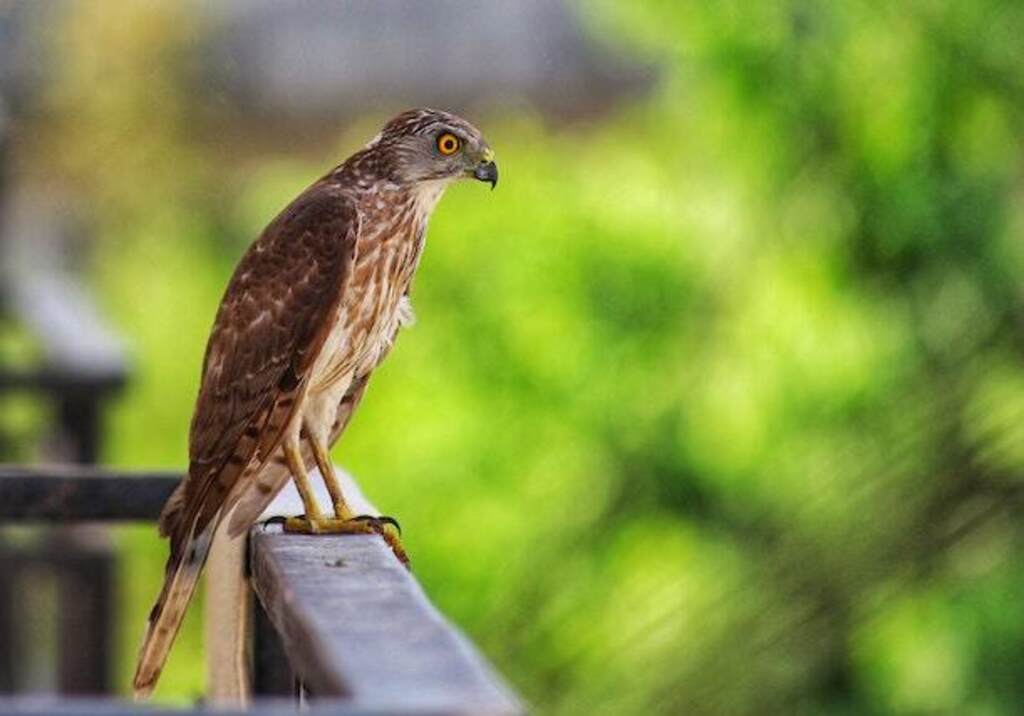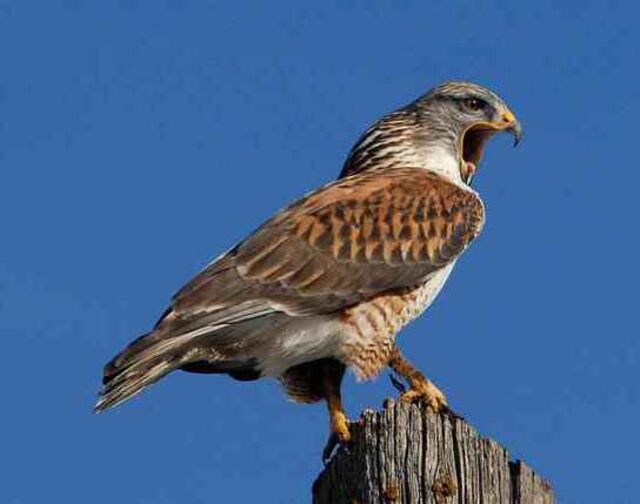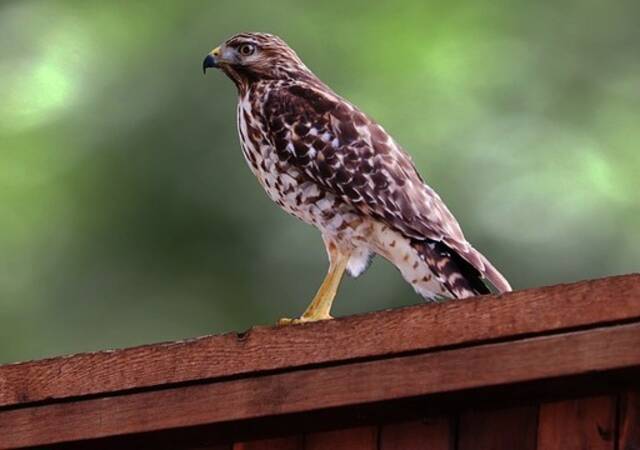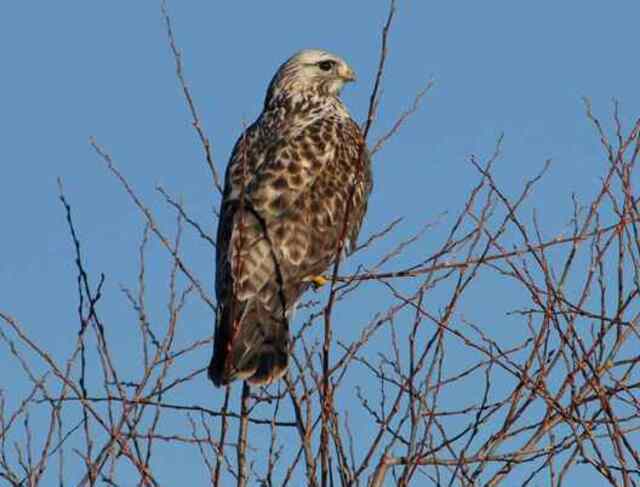Birds of prey such as hawks have fascinated humans for centuries with their incredible hunting abilities and keen senses. Of all their senses, their vision is arguably their most impressive, allowing them to hunt prey with incredible accuracy and speed.
But how do hawks see? What makes their vision so exceptional, and what adaptations have they evolved to make them such efficient hunters?
In this article, we will explore the anatomy of a hawk’s eye, the visual adaptations that allow them to see their prey from great distances, and how their vision compares to that of humans.
We will also delve into the hunting techniques of hawks and the environmental factors that affect their vision.
Finally, we will discuss the importance of conservation and research efforts in understanding these birds and preserving their habitats for future generations.
Through this exploration, we hope to gain a deeper understanding of these incredible creatures and the remarkable abilities that allow them to soar freely through the skies.
Table of Contents
- 1 Key Takeaways
- 2 Overview of Hawks and their Hunting Abilities
- 3 Anatomy of a Hawk’s Eye
- 4 Visual Adaptations of Hawks
- 5 Hawk Vision vs. Human Vision
- 6 Hunting Techniques of Hawks
- 7 Environmental Factors Affecting Hawk Vision
- 8 Conservation and Research Efforts
- 9 Frequently Asked Questions
- 10 Conclusion
- 11 Author
Key Takeaways
- Hawks have exceptional vision, with a large cornea and lens that captures more light and focuses it onto the retina.
- Their binocular vision is crucial for accurate depth perception, and they can detect ultraviolet light, aiding in locating prey, identifying other birds, and navigating their environment.
- Weather and lighting conditions can impact hawk vision and their ability to locate prey, making it more challenging for them to hunt.
- Conservation efforts are crucial in protecting hawk populations from threats such as habitat loss, predation, and pesticide use.
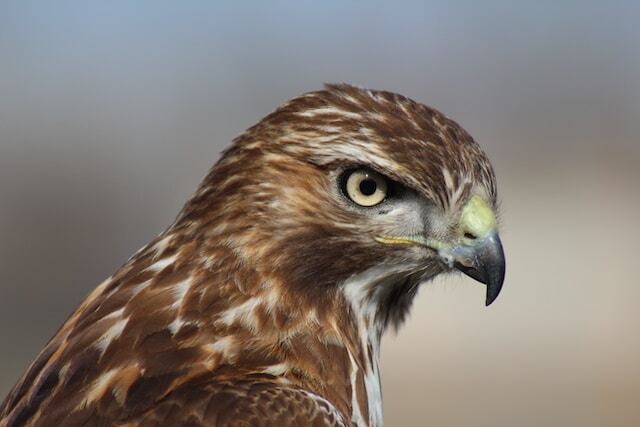
Overview of Hawks and their Hunting Abilities
Hawks, with their keen eyesight and impressive speed, are able to effectively hunt prey both on the ground and in the air.
Their adaptive advantages, such as their superior vision, allow them to spot prey from great distances and quickly swoop down to capture it.
Hawks have a unique hunting behavior that involves scanning their surroundings while perched on high vantage points, then diving down to catch their prey with their sharp talons.
Their ability to hunt both small and large prey makes them a formidable predator.
Understanding the anatomy of a hawk’s eye is crucial to understanding how they are able to achieve such incredible feats of hunting prowess.
Anatomy of a Hawk’s Eye
The ocular structure of a raptor’s eye allows for superior visual acuity and depth perception, making it a formidable predator in the animal kingdom.
The hawk eye anatomy is designed for optimal function, with a large cornea and lens that aids in capturing more light and focusing it onto the retina.
The retina also contains a high density of cone cells, which are responsible for color perception, allowing hawks to see a wide range of colors that are invisible to humans.
Additionally, the shape of a hawk’s eye is elongated, with a high number of photoreceptor cells that enable the bird to see fine details and movements at great distances.
The hawk’s eye is also able to adjust to different lighting conditions, allowing it to hunt during the day and in low light conditions.
With its superior visual acuity and color perception, the hawk is a successful predator that is able to detect prey from afar.
The next section will discuss the visual adaptations of hawks in more detail.
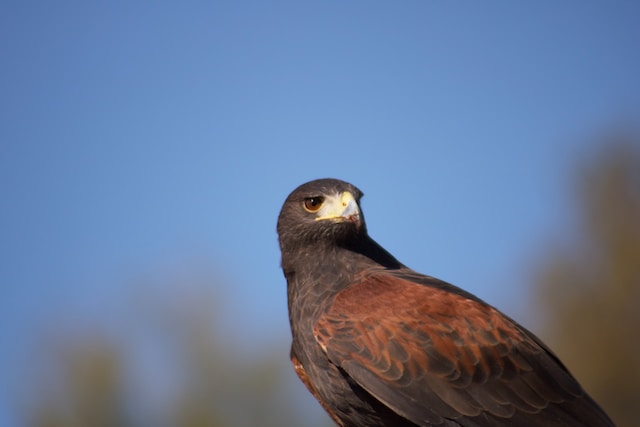
Visual Adaptations of Hawks
Hawks possess an array of visual adaptations that enable them to excel as predatory birds.
Their binocular vision, for instance, is crucial for accurate depth perception, which is necessary for hunting prey in flight.
Additionally, their eyes can detect ultraviolet light, which is invisible to human eyes and aids in locating prey, identifying other birds, and navigating their environment.
Binocular Vision
Through the use of their binocular vision, birds of prey are able to accurately focus on and capture their prey, evoking a sense of awe and admiration for their impressive hunting abilities.
This ability is due to the neurological processing of their vision, which allows for the integration of the two images from their eyes into a single, stereoscopic image.
This gives them a sense of depth perception that is far superior to that of humans.
In addition, hawks have a high concentration of photoreceptors in the fovea of their eyes, which enables them to see fine details and movements from great distances.
Their eyes are also able to rapidly adjust to changes in lighting conditions, allowing them to hunt at any time of day or night.
Ultimately, the binocular vision of hawks provides them with the tools needed to survive in their environment, giving them a sense of freedom in their ability to hunt and thrive in their natural habitat.
With their superior depth perception and other visual adaptations, hawks are a testament to the remarkable capabilities of the natural world.
Superior Depth Perception
By utilizing their binocular vision, birds of prey have a remarkable ability to accurately perceive the distances and positions of their prey, a skill that is revered in the natural world.
Hawks, in particular, have exceptional visual acuity and are able to detect even the slightest movement of their prey from a great distance.
Their superior depth perception allows them to judge the distance of their prey with great accuracy, enabling them to swoop down with precision and capture their target.
This ability is crucial in predator-prey interactions as it allows hawks to successfully hunt and survive in their environment.
Furthermore, this skill is also important in avoiding potential threats, as hawks can detect the distance and position of predators from afar.
The hawk’s superior depth perception, combined with their keen sense of hearing and sharp talons, make them a formidable predator in the animal kingdom.
Moving on to the next section, the hawk’s ability to detect UV light is another fascinating aspect of their vision.
Ability to Detect UV Light
The avian visual system has the remarkable ability to detect ultraviolet light, which is invisible to humans and many other animals. This ability is due to the presence of a specialized receptor in birds’ eyes called the UV-sensitive cone.
Here are four ways in which UV light detection provides an evolutionary advantage to hawks:
1) Hawks can see patterns on prey animals that are invisible to humans, which can help them identify prey from a distance.
2) The ability to detect UV light allows hawks to see urine markings left by prey, which can help them track prey.
3) Hawks can also see UV patterns on feathers, which can help them identify healthy individuals for potential mates or rivals.
4) The ability to see UV light also helps hawks navigate using the sun’s position, as the sun emits UV radiation that can be used for orientation.
Overall, the ability to detect UV light provides hawks with a significant advantage in hunting, navigation, and social interactions. This ability sets their visual system apart from that of humans and many other animals.
In the next section, we will compare hawk vision to human vision and explore the differences between the two.
Hawk Vision vs. Human Vision
A comparison between the vision of hawks and humans reveals distinct differences in their visual capabilities.
Hawks possess extraordinary visual acuity, allowing them to see prey from great distances and detect even the slightest movement.
In contrast, humans have limited visual acuity and rely heavily on color vision and depth perception.
Hawks also have a wider field of view, with a binocular vision that allows them to focus on one object while still being aware of their surroundings.
This is crucial for their hunting strategies, as they need to be able to detect prey while in flight and navigate through their environment.
Additionally, hawks have visual adaptations that enable them to see in different light conditions, such as UV light, which humans cannot see.
Overall, hawk vision is specialized for prey detection and flight patterns, while human vision is adapted for color perception and fine detail.
Understanding these differences in visual capabilities can help us appreciate the unique abilities of hawks and the environmental factors that influence their evolution.
In the subsequent section, we will explore the hunting techniques of hawks and how their visual adaptations play a crucial role in their success.
Hunting Techniques of Hawks
Hunting techniques of hawks involve a complex combination of visual, physical, and behavioral adaptations that allow them to successfully catch their prey.
Prey selection is a crucial part of the hunting process, and hawks are known to have a wide range of prey that they can target.
They use their sharp eyesight to spot their prey from high up in the air, and then dive towards it at high speeds to catch it.
Hawks are also known to use hunting strategies such as ambush, pursuit, and soaring to catch their prey.
They use their sharp talons to hold onto their prey while using their sharp beaks to kill it.
Environmental factors such as weather conditions, availability of prey, and the presence of other predators can also affect the hunting success of hawks.
It is important to understand the hunting techniques of hawks to appreciate their unique adaptations and survival strategies in the wild.
Environmental Factors Affecting Hawk Vision
Environmental factors play a crucial role in determining the effectiveness of hawk vision. Weather and lighting conditions, such as cloud cover, precipitation, and time of day, can influence the clarity and brightness of the images perceived by hawks.
Habitat and prey availability also impact hawk vision, as different environments and prey types may require varying degrees of visual acuity and depth perception.
Lastly, migration and navigation patterns can affect hawk vision, as hawks rely heavily on visual cues to navigate during their long-distance journeys.
Understanding the environmental factors that affect hawk vision is essential for comprehending the complexities of their hunting strategies and survival.
Weather and Lighting
The visual acuity of hawks is greatly influenced by the weather and lighting conditions in their habitat, which can impact their ability to locate prey.
Environmental factors such as climate change and pollution have significantly affected the weather patterns and lighting conditions of many habitats, which in turn can affect the hunting success of hawks.
For example, changes in temperature and precipitation can alter the behavior and distribution of prey species, making it more challenging for hawks to locate them.
Similarly, pollution can reduce visibility and make it more difficult for hawks to see potential prey.
To compensate for these changes, hawks may adjust their hunting strategies or shift to habitats that offer better lighting and weather conditions.
The interplay between weather, lighting, and habitat is crucial in understanding how hawks see and locate prey, and underscores the importance of preserving natural habitats for these magnificent birds of prey.
Habitat and Prey
The availability and distribution of prey in a hawk’s habitat is intricately linked to their survival and population dynamics.
Hawks are known to be opportunistic predators that hunt a variety of prey species, ranging from small rodents and birds to larger mammals like rabbits and hares.
Prey populations can fluctuate greatly due to factors such as climate change, habitat destruction, and hunting pressures, which can have a significant impact on hawk populations.
Habitat preservation is crucial for maintaining healthy prey populations and ensuring the long-term survival of hawks.
Conservation efforts aimed at protecting and restoring habitats can help to stabilize prey populations and promote healthy ecosystems.
Understanding the complex dynamics between hawks and their prey is essential for effective conservation management.
In the next section, we will explore how hawks navigate and migrate to different habitats in search of prey.
Migration and navigation are crucial skills that hawks possess, allowing them to travel long distances to find suitable habitats and prey.
Hawks use a combination of sensory cues to navigate, including the use of Earth’s magnetic field and celestial cues such as the position of the sun and stars.
This ability to navigate is essential for their survival, as they need to be able to locate food and suitable habitats.
However, climate change is having a significant impact on migration patterns, with some species of hawks traveling shorter distances or not migrating at all.
This has important implications for their survival and highlights the importance of conservation efforts to protect their habitats and ensure their long-term survival.
By studying their migration patterns and the cues they use for navigation, researchers can better understand the impact of climate change on these species and develop strategies to protect them.
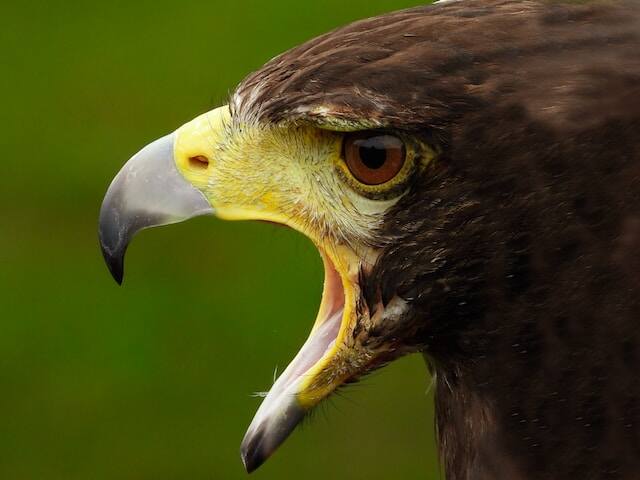
Conservation and Research Efforts
Conservation and research efforts have been instrumental in addressing the threats to hawk populations, which include habitat loss, deforestation, and hunting.
Hawk monitoring and research have provided insights into the behavior, ecology, and distribution of various hawk species.
Protection and rehabilitation efforts have also been undertaken to mitigate the impact of human activities on hawk populations, including the establishment of protected areas, rescue and rehabilitation centers, and public awareness campaigns.
Threats to Hawk Populations
Predation by other animals, habitat loss, and pesticide use are among the major threats facing hawk populations around the world.
Human impact is the primary cause of these threats, leading to a decline in hawk population.
The loss of natural habitats due to urbanization and deforestation forces hawks to adapt to new environments, which can be difficult and dangerous.
Pesticide use, especially in agriculture, has caused significant harm to hawk populations as they accumulate toxins in their bodies through consumption of contaminated prey.
Additionally, hawks face predation from other animals, such as raccoons, snakes, and coyotes, which can reduce their numbers.
To provide a visual representation of these ideas, the following table presents the major threats to hawk populations and their impacts:
| Threats | Impacts |
|---|---|
| Habitat loss | Disruption of nesting and feeding habitats |
| Pesticide use | Toxins accumulate in the hawk’s body leading to illness and death |
| Predation | Reduction in hawk population |
Understanding these threats is crucial for designing effective conservation strategies and monitoring hawk populations.
Therefore, it is important to invest in research efforts to better understand the complex interactions between hawks and their environment.
In the next section, we will discuss the importance of hawk monitoring and research in greater detail.
Hawk Monitoring and Research
Research efforts are fundamental to comprehensively understand the complex interactions between hawk populations and their environment.
With the aid of tracking technology, researchers can gather detailed information on the movements, behaviors, and habitats of hawks, which can inform conservation strategies.
Hawk monitoring and research typically involve the following:
1) tagging hawks with GPS or radio transmitters to track their movements,
2) collecting data on food sources and reproductive success,
3) analyzing habitat use and migration patterns, and
4) conducting surveys to estimate population size and trends.
Such research can identify critical habitats, migration routes, and potential threats to hawk populations, and inform the development of conservation plans.
By gaining a better understanding of hawk populations, researchers can design effective strategies that can counteract the negative impacts of habitat loss, pesticide use, and predation on these birds.
Protection and rehabilitation of injured or orphaned hawks are also crucial for maintaining healthy populations.
Protection and Rehabilitation
Protection and rehabilitation efforts are essential in ensuring the survival of hawk populations, as injured or orphaned birds require human intervention to recover and return to the wild.
Rehabilitation techniques, such as physical therapy, medication, and proper nutrition, are used to treat injuries and illnesses.
Conservation efforts also include the creation of protected habitats, such as nesting sites and hunting grounds, and monitoring the population through tracking and banding programs.
These efforts have been successful in increasing hawk populations in some areas, such as the Peregrine Falcon, which was once endangered but has made a remarkable recovery due to conservation efforts.
However, more work needs to be done to protect and rehabilitate other species of hawks, as habitat loss, climate change, and human activity pose significant threats to their survival.
In conclusion, protection and rehabilitation efforts play a crucial role in maintaining hawk populations and ensuring their survival in the wild.
Frequently Asked Questions
What is the lifespan of a hawk?
The lifespan of a hawk varies by species, but typically ranges from 10-25 years. Factors such as diet and feeding habits can impact their longevity. Hawk migration patterns also play a role in their lifespan, as they face many challenges during their long journeys.
How do hawks communicate with each other?
Hawks communicate through vocalizations and visual cues, such as posturing and body language. Their calls vary depending on the situation, ranging from territorial warnings to courtship displays. These behaviors allow for effective communication and coordination within their social groups.
What is the largest species of hawk?
The largest hawk species is the Harpy eagle, known for its distinctive physical characteristics such as a wingspan of up to 7 feet and a powerful grip capable of crushing prey. Its habitat is the tropical rainforests of South America.
Do hawks have any natural predators?
Hawks are apex predators and have few natural predators. However, they are still part of the predator prey dynamics within their ecosystem. Maintaining a balance between predator and prey is crucial for the health and stability of the ecosystem.
How do hawks mate and reproduce?
Female hawks select their mates based on their behavior during courtship displays. Mating habits vary by species, with some pairs bonding for life. The reproductive cycle involves laying eggs, incubation, and feeding the hatchlings until they fledge.
Conclusion
In conclusion, the hunting abilities of hawks are a marvel of nature. Their anatomy, visual adaptations, and hunting techniques all contribute to their success in catching prey.
The unique structure of a hawk’s eye allows for exceptional vision, far surpassing that of humans. The ability to see ultraviolet light and detect prey from great distances is a testament to their visual prowess.
While hawks possess impressive abilities, they are not invincible. Environmental factors such as weather conditions and habitat destruction can greatly affect their hunting success.
Conservation efforts are necessary to ensure the continued survival of these magnificent birds.
In summary, the world of hawks is one of astounding visual acuity, remarkable hunting techniques, and delicate balance with their environment.
Their exceptional abilities are a wonder to behold, but also a reminder of the importance of conservation and research efforts to protect these creatures and their habitats.

